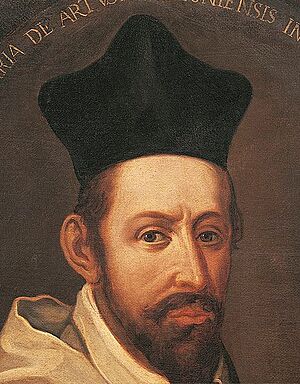Giovanni Artusi facts for kids
Giovanni Maria Artusi (born around 1540, died August 18, 1613) was an Italian music theorist, composer, and writer. He is famous for strongly disagreeing with new music styles that started appearing around 1600. These new styles later became known as early Baroque music.
Artusi was also a scholar and a priest. He always respected his teacher, Gioseffo Zarlino, who was a very important music theorist in the late 1500s. When another musician, Vincenzo Galilei, criticized Zarlino in 1581, Artusi defended his teacher and the older style of music he represented.
Contents
Artusi and the New Music
Artusi wrote a book called L'Artusi, overo Delle imperfettioni della moderna musica. This translates to "Artusi, or On the Imperfections of Modern Music." In this book, he sharply criticized the new musical ideas of his time.
In 1600 and 1603, Artusi specifically attacked the music of a composer he didn't name at first. This composer was Claudio Monteverdi. Artusi called Monteverdi's music "rough" and "too free."
The Great Music Debate
Monteverdi responded to Artusi's criticisms in 1605. He explained that music could be divided into two main types:
- Prima pratica: This was the older style of music from the 1500s. It focused on polyphony, where many voices or parts sing together, each equally important. It had smooth melodies and carefully prepared dissonances (notes that sound clashing).
- Seconda pratica: This was the new style of music. It focused on a single main melody, often sung by a soprano (high voice), with a strong bass line supporting it. This style allowed for more dramatic use of dissonance and was often used in recitative (a style of singing that sounds like speaking).
Monteverdi argued that the prima pratica was about harmony and rules, while the seconda pratica was about expressing emotions through the words.
Artusi's Contributions to Music Theory
Artusi's most important book on music theory was L'Arte del contraponto (The Art of Counterpoint), published in 1598. Counterpoint is the art of combining different melodies that sound good together.
In this book, Artusi understood that a piece of music could have more dissonance than consonance (notes that sound pleasant together). He tried to explain why and how dissonances were used. For example, he noted that dissonances could be used to express feelings like sadness, pain, or fear in music.
It's interesting that Monteverdi's new seconda pratica style actually used dissonance in ways that agreed with Artusi's ideas, at least in concept. The main differences were how important each voice was and the exact notes used in the melodies.
Artusi's Compositions
Artusi did not compose many pieces of music. His compositions were in the older, more traditional style. He published:
- One book of canzonette (light, short songs) for four voices in Venice in 1598.
- A piece called Cantate Domino for eight voices in 1599.
Modern Views on the Debate
Some modern scholars have looked at the Artusi-Monteverdi debate in new ways. For example, Suzanne Cusick suggested in 1993 that Artusi's attack on Monteverdi might have been an attempt to make modern music seem "unnatural." Other experts, like Ilias Chrissochoidis and Charles S. Brauner, have questioned this idea, saying that such interpretations can sometimes project modern ideas onto the past.
See also
 In Spanish: Giovanni Artusi para niños
In Spanish: Giovanni Artusi para niños


